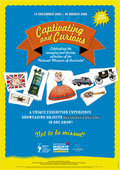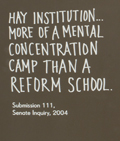Captivating and curious
An exhibition case study
by Guy Hansen
Their ephemeral nature means that many exhibitions leave little trace after they have been de-installed. If not documented when in place, information about what objects were used and how they were interpreted can be lost. This article provides the curator's overview of an exhibition celebrating the National Museum of Australia's 25th anniversary.
‘Let our histories be visible’
Human rights museology and the National Museum of Australia’s Inside: Life in Children’s Homes and Institutions
In 2011–12 the National Museum of Australia developed and mounted the exhibition Inside: Life in Children’s Homes and Institutions, in fulfilment of the Australian Government’s promise to the Forgotten Australians and Former Child Migrants. The National Museum of Australia is well placed to embrace and lead a national approach to a socially responsible — and responsive — human rights museology. However, there seemed to be an initial reluctance on the part of the Museum to create an exhibition about Forgotten Australians, and the scope, positioning and temporary nature of the exhibition reflect this. Why this unwillingness? Is the National Museum guilty of a ‘dinosaur’ mentality? Is there a museology that counters this reluctance?


